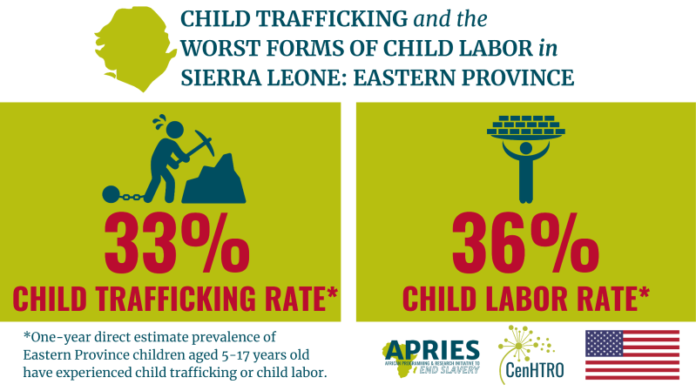By Amin Kef Sesay
In a Release by the Center on Human Trafficking Research & Outreach (CenHTRO) an estimated 33% of children aged 5 to 17 in Sierra Leone’s Eastern Province have experienced child trafficking and 36% have experienced child labor, according to new research from the African Programming & Research Initiative to End Slavery (APRIES) at the University of Georgia’s Center on Human Trafficking Research & Outreach (CenHTRO).
“Child Trafficking and the Worst Forms of Child Labor in Sierra Leone,” is the largest scale household survey on the topic ever undertaken in Sierra Leone and offers key detail into how and why child trafficking happens in the country.
The report specifically describes child trafficking and child labor in Sierra Leone’s Eastern Province. Child trafficking rates there are 46% in Kono, 33% in Kailahun, and 27% in Kenema. Child labor rates are 52% in Kono, 34% in Kailahun, and 29% in Kenema.
The nature of trafficking in Sierra Leone results in Eastern Province children being taken outside the region, often to more urban areas. The report’s insight and recommendations therefore have the potential to improve children’s lives across the country.
“Without reliable estimates of child trafficking and child labor, government and NGOs cannot have a baseline to work from, making it impossible to know if we are making progress in reducing the problem,” said CenHTRO Director David Okech, principal investigator for the report. “The high number of children in trafficking and labor is quite significant, and our goal is to partner in prevention, prosecution, and protection efforts to reduce the problem over time.”
Trafficking most commonly occurred when a child was relocated away from their biological family by someone offering the promise of educational opportunities, following the tradition of menpikin. Instead, away from home, the child experienced forced labor, was denied necessities like food and shelter, and lacked access to school. In some instances, relatives or acquaintances trafficked the child. The report proposes that bad actors can abuse menpikin.
“We were poor, and my mother could not cater for my needs, so she saw an opportunity in my trafficker’s request to take me away. [The trafficker] promised [my mother] of giving me a better education,” one survivor said in an interview.
“I am the only one doing all the work and she did not send me to school,” another survivor said in an interview.
Survivors primarily described being forced into domestic work or street vending. Others reported being forced to participate in hazardous labor in the fishing, mining, or construction industries.
The report identifies the populations most vulnerable to trafficking as: 12-to-17-year old children, children who have lost one or both parents, and children not enrolled in school.
The report defines child trafficking, in accordance with the United Nations’ Palermo Protocol, as the recruitment, transportation, transfer, harboring, or receipt of a person under the age of 18 for any form of exploitative labor or commercial sex act. Child labor is any work that deprives children of their childhood, their potential and their dignity, and that is harmful to physical and mental development.
Policymakers, service providers, and communities can employ the data to guide programming, legislation, and policies that will mitigate future exploitation of children in Sierra Leone.
“This comprehensive study provides new evidence of the nature of the problem in the country,” said Sierra Leone Minister of Social Welfare Baindu Dassama. Multiple Sierra Leone ministries partnered with APRIES on the study. “Government welcomes the research findings because it provides us a toll for enhancing our existing response and prevention interventions through appropriate policies, programs, and actions.”
Between 2019 and 2020, researchers conducted over 3000 household surveys, interviewed survivors, parents, and key stakeholders, and organized 23 focus groups. Sierra Leone’s Conflict Management and Development Associates and the Resilient Africa Network, a research organization at Makerere University in Uganda, collected the data under the immense pressures presented by the Covid-19 pandemic. The US Department of State Office to Combat and Monitor Trafficking in Persons’ Program to End Modern Slavery funded the research.
To begin to address trafficking in the country, the Government of Sierra Leone passed anti-trafficking legislation in 2005. It also launched the Free Quality School Education Program to improve access to school and created the Hands Off Our Girls Campaign to raise awareness about gender-based violence. But the report recommends much more be done.
The report’s recommendations include greater safeguards for children in informal fostering arrangements; increased access to educational opportunities, especially for children living without one or both parents; and, overall, increased collaboration and cooperation throughout Sierra Leone society— between government agencies, families, community leaders, and all non-government stakeholders—to prevent trafficking and support survivors.
Following this report, APRIES and CenHTRO have planned an endline study, beginning in 2022, that will assess changes in the prevalence of child trafficking and measure the impact of current anti-trafficking initiatives. Additional research projects that extend or expand upon the report are in development or ongoing.




